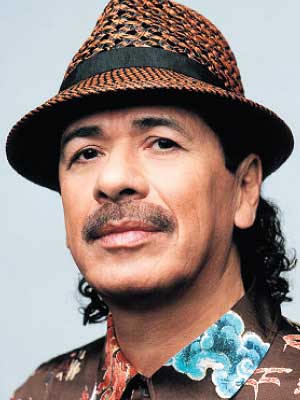Matchless gifts: Pele’s feet and Santana’s hands
Opinion by Jorge Ramos[tabs type=”horizontal”]
[tabs_head][tab_title]English[/tab_title]
[tab_title]Español[/tab_title][/tabs_head]
[tab]The World Cup will end on a high note on Sunday (July 13) when guitarist Carlos Santana performs during the closing ceremony in Rio de Janeiro.
Although he hates FIFA’s game protocols, Santana will rock the planet with his magical fingers. He might even take the opportunity to make a statement, which will be more spiritual than musical.
I spoke to Santana recently during a promotional tour for his latest album, “Corazon” (“Heart” in English), which features performances by several Latin American artists. Although it’s high on the charts in several countries, Santana didn’t want to discuss record sales – or soccer. He had nationalism on his mind.
“We use music to unify this planet,” he said when we met in May. “We need to put aside the concept of patriotism, because patriotism is prehistoric.”
That idea, of course, runs counter to the World Cup’s monthlong exhibition of patriotism. As 32 nations competed, there were displays of deep-rooted forms of nationalism – both on the field and in the seats.
But the musician, whose hits such as the song “Oye Como Va” (“Listen to How It Goes” in English) and the album “Supernatural” have broken records worldwide, insisted on his point: Unity, not division, should be the focus of an event such as the World Cup.
“A positive thought creates thousands of positive vibrations,” he said. “Only those who see the invisible can do the impossible.”
When we spoke, Santana was dreaming about bringing together Pope Francis, the Dalai Lama and several presidents, including U.S. President Barack Obama, for a peace conference. I believe that idea faded, but during the closing ceremony, Santana will improvise a revolution with the fastest fingers in rock and roll. What is it that he does onstage?
“I call it taking my fingers for a walk,” he said. “I don’t want to lose the glee. I didn’t have a childhood. I was a child when I was already helping my dad in Tijuana make money to feed my four sisters and my two brothers.”
The 66-year-old said he feels like he’s 14 when he plays the guitar.
I asked if I could look at his fingers, expecting them to be calloused, scarred and crooked after a lifetime of work. Instead his fingertips are rounded, the shape of his fingers impeccable, as if he had never touched a guitar. They are like Pele’s feet – a wonder of the world.
In a way, this World Cup brings the two men together. The year 1969 was important for both of them; one entered the history books with his fingers, the other with his feet. Santana became a legend at Woodstock, while Pele, in turn, scored his 1,000th goal that year. He was playing for Santos FC, a Sao Paulo team, against CR Vasco da Gama on their home turf, in Rio’s Maracana Stadium.
Pele was the greatest soccer player ever. I know this is a subjective judgment. After all, he marked my childhood, as he did that of millions. His first goal against Italy, in the final match of the 1970 World Cup in Mexico, is engraved on me like a tattoo. The only person to have won three World Cups during his career, his feet were a magnet for the ball. Once he was on the field, it was impossible to take your eyes off of him.
I’m obligated to mention that others believe that Argentina’s Diego Armando Maradona was the greatest – and according to a 2002 FIFA poll, he scored the best goal in history. During the 1986 World Cup quarterfinals, Maradona took on almost the entire English team, starting from the center of the field, and scored. These days, Lionel Messi, Neymar and James Rodriguez put on a good show, but they’re not yet as strong as Maradona and Pele. (On a side note, this cup also has confirmed what I’ve always said: Latin American soccer is more fun than the buttoned-up European approach.)
Whatever the outcome, this World Cup is historic. It’s not just because of the goals or the terrific performances by the goalies – Guillermo Ochoa of Mexico, David Ospina of Colombia, America’s Tim Howard, Costa Rica’s Keylor Navas – or the unexpected losses (whatever happened to Spain, Britain, Italy and Portugal?). This World Cup has brought us together – and promises to break every record.
In 2010, 909 million people watched the closing ceremony of the South African World Cup. That’s many times more than the 109 million people who watched the last Super Bowl. This year, I expect the audience will be measured in billions.
Because of my job, I’ll be lucky enough to attend the final match at Maracana. I’m taking my son Nicolas. I want him to know that Santana’s fingers, Pele’s feet and a well-played game of soccer are matchless gifts – and seeing them is one of life’s great pleasures.
Just as Santana is hoping, such joys unite us – and that’s perhaps the best kind of peace conference.[/tab]
[tab]El Mundial terminará con una nota muy alta. El guitarrista Carlos Santana, único y genial, tocará en la ceremonia de clausura en Río de Janeiro.
Sé que odia los protocolos y las trampas de la FIFA, pero el planeta vibrará con sus dedos mágicos. Y quizá hasta nos sorprenda con alguna de sus inusuales declaraciones, más espiritual que musical o futbolera.
Hablé hace poco con él durante la gira de promoción de su álbum “Corazón”, realizado con artistas latinoamericanos y que está en los primeros lugares de ventas en varios países. Pero él no quería hablar de ventas, dinero o fútbol.
“Usamos la música para unificar este planeta”, me dijo. “Hay que hacer a un lado el concepto de patriotismo porque el patriotismo es prehistórico”. Su idea, por supuesto, choca de golpe con un mes de recalcitrante patriotismo en el Mundial; 32 equipos se han rasgado las camisetas y han aflorado los más extremos nacionalismos y fobias en la cancha y en las tribunas.
Pero él insiste. “Un pensamiento positivo crea millones de vibraciones positivas”, me dijo el autor de “Oye Cómo Va” y de “Supernatural”. “Solamente los que ven lo invisible hacen lo imposible”.
Cuando hablé con Santana traía en mente uno de esos proyectos imposibles: juntar al Papa Francisco, al Dalai Lama y a varios presidentes, incluyendo a Barack Obama, en una conferencia por la paz. Estaba dispuesto a tocar para todos ellos y a ellos les tocaba hacer la paz.
La idea, creo, se esfumó. Pero en la clausura del Mundial, las notas de los dedos más rápidos del rock van a improvisar una revolución. ¿Qué hace Santana en un escenario? “Yo sólo llevo a mis dedos de paseo”, refirió. “No quiero perder mi capacidad de asombro. No tuve una niñez. Cuando era niño tenía que ayudar a mi papá en Tijuana para alimentar a mis cuatro hermanas y dos hermanos”. Este hombre de 66 años dice que se siente de 14 cuanto toca la guitarra.
Santana no saluda de mano. Da abrazos. A todos. Pero durante la entrevista le pedí si podía tocar sus dedos. Me los imaginaba largos y callosos, llenos de marcas y torcidos de historia. En cambio me encontré 10 dedos de bebé, llenitos, impecables, como recién hechos, como si nunca en la vida hubieran tocado una cuerda.
Los dedos de Carlos Santana y los pies de Pelé están, sin duda, entre las maravillas del mundo. Y este Mundial los une.
El año 1969 fue muy importante para Santana y Pelé. Santana se dio a conocer mundialmente en el festival de Woodstock. Ahí comienza la leyenda. Pelé, en cambio, metió ese mismo año su gol número mil en el estadio de Maracaná en contra del equipo Vasco da Gama. En ese 1969 – uno con sus dedos y otros con sus pies – pasan a la historia.
Pelé es, para mí, el mejor jugador que ha existido. Es el único con tres campeonatos del mundo. Era un imán. Una vez en la cancha, era imposible perderlo de vista. Éste es, lo sé, un juicio enteramente personal. Su primer gol contra Italia en la final del Mundial en México en 1970 lo tengo grabado como un lunar. Marcó mi niñez y la de millones más.
Para otros, sin duda, el mejor del mundo ha sido Diego Armando Maradona. Una encuesta de la FIFA en el 2002 le atribuyó a él el mejor gol de la historia. En el Mundial de 1986, en cuartos del final, Maradona se lleva a casi todo el equipo de Inglaterra desde la mitad de la cancha para anotar. Lionel Messi, Neymar y James Rodríguez son un espectáculo. Pero todavía no son como Maradona y Pelé.
El de Brasil ha resultado ser un gran Mundial. No sólo por los goles, o por la impresionante actuación de los porteros —Guillermo Ochoa de México, David Ospina de Colombia, el jugador estadounidense Tim Howard, Ketlor Navas, de Costa Rica— o las inesperadas derrotas (¿qué les pasó a España, Gran Bretaña, Italia y Portugal?). Y la comprobación de que el fútbol latinoamericano es muchas veces más divertido y efectivo que el europeo.
El Mundial no tiene comparación. En la ceremonia de clausura del Mundial en Sudáfrica en el 2010 hubo 909 millones de televidentes. Esto es mucho más de los 111 millones de espectadores que vieron por televisión el último Súper Bowl. El de Brasil promete romper todos los récords. En Internet y en las redes sociales ya lo hizo.
Mi trabajo —una bendición— me permitirá estar en la final en el Maracaná. Y me llevo a mi hijo, Nicolás. Quiero que sepa que los dedos de Santana, los pies de Pelé y el fútbol son un regalo imposible de empatar.[/tab][/tabs]










